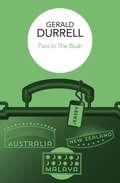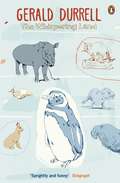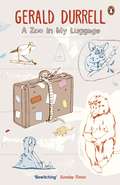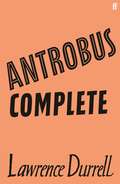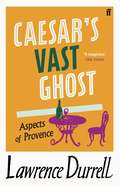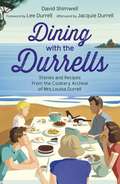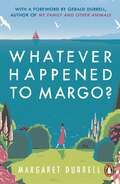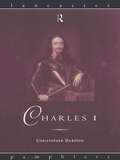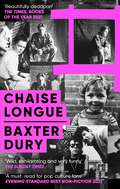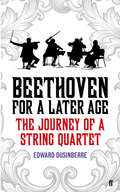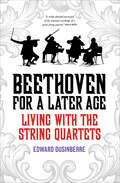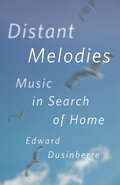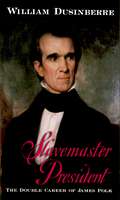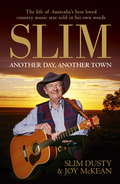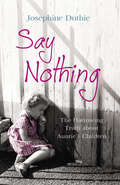- Table View
- List View
Three Singles to Adventure
by Gerald DurrellGerald Durrell is on his way to South America on a quest to capture specimens that have never before been brought back alive. And it turns into quite an adventure when he encounters timid squirrel monkeys, wailing rats, an overly affectionate bird christened Cuthbert and a bad-tempered anaconda! Bringing back a living collection of animals can be frustrating, exciting and damned hard work, but it’s never dull!
Two in the Bush (El\libro De Bolsillo Ser.)
by Gerald DurrellTwo in the Bush is a record of the six-month journey which took Gerald Durrell, his wife Jacquie, and two cameramen through New Zealand, Australia and Malaya. The object was, first, to see what was being done about the conservation of wild life in these countries, and, secondly, to make a series of television films for the BBC. They were introduced to many rare and remarkable animals – Royal Albatrosses, Tuataras, Duck-Billed Platypuses, Flying Lizards and Long-Nosed Bandicoots, as well as to some equally unusual humans. Anyone who has read The Overloaded Ark, The Bafut Beagles or The Whispering Land will have enjoyed Gerald Durrell’s enthusiastic adventuring and his delight in the absurdity of the situations in which he finds himself. His observation of animal – and human – behaviour is always informative and often hilarious. ‘Delightfully readable and often very funny.’ Daily Mail ‘An account of Gerald Durrell’s tour of New Zealand, Australia and Malaya in search of rarities . . . Easy to read, difficult to put down, with many vivid sidelights on the human side of the expedition. This absorbing narrative reveals the ardours, ironies and disappointments, the organizational miracles and the hilarious human mishaps . . .’ Maurice Wiggin, Sunday Times ‘Mr Durrell has the knack of writing about animals and their antics with tremendous affection and enthusiasm, but without sentimentality.’ Sunday Telegraph ‘Will delight his fans and armchair naturalists everywhere.’ Evening Standard
The Whispering Land: A Zoo In My Luggage, The Whispering Land, And Menagerie Manor (The\zoo Memoirs Ser. #2)
by Gerald Durrell'When you have a large collection of animals to transport from one end of the world to the other you cannot, as a lot of people seem to think, just hoist them aboard the nearest ship and set off with a gay wave of your hand.'Gerald Durrell and his wife are the proud owners of a small zoo on the island of Jersey. But there's one thing that's better than a small zoo - a bigger one! So Durrell heads off to South America to collect more animals.Along windswept Patagonian shores and in Argentine tropical forests, he encounters a range of animals from penguins to elephant seals. But as always, he is drawn to those rare and interesting creatures which he hopes will thrive and breed in captivity . . .Told with enthusiasm and without sentimentality, Gerald Durrell's The Whispering Land is an often hilarious but always inspiring foray into the South American wilds.
A Zoo in My Luggage: A Zoo In My Luggage, The Whispering Land, And Menagerie Manor (The\zoo Memoirs Ser. #1)
by Gerald DurrellThe true and hilarious story of how Gerald Durrell and his wife set up their own zoo. Journeying to the Cameroons, he and his wife, helped by the renowned Fon of Bafut, managed to collect 'plenty beef.' Their difficulties began when they found themselves back at home, with Cholmondely the chimpanzee, Bug-Eye the bush-baby, and other founder members... and nowhere to put them
Antrobus Complete
by Lawrence DurrellThe British Foreign Office is a timeless institution. Antrobus is the embodiment of everything that makes it what it is. His tales of diplomatic misadventure, accompanied by memorable and witty drawings, make a collection to cherish, for as long as the Foreign Office holds sway over far-flung British interests.'Whatever wars there may be and whatever crises, there will still, please heaven, be the diplomatic corps, with its protocol and formalities and a field of humour which I have never seen better used than in these stories.' John Betjeman
Caesar's Vast Ghost: Aspects Of Provence
by Lawrence DurrellProvence, Southern France. Celebrated writer and poet Lawrence Durrell made the Midi his home for more than thirty years: and in this classic memoir, his final book, he shares his most evocative, dazzling memories of life as a local. A seductive blend of travelogue, poet's notebook, and intimate autobiography, Durrell guides us through the rich layers of human history that lie beneath the region's legendary landscapes. From stories of magic and mythology infusing the rolling vineyards and vivid lavender fields to tales of Roman conquest, bull-worship, and courtly love beneath the wounded blue skies, Ceasar's Vast Ghost is a book to be treasured.'A richly characteristic bouillabaisse by our last great garlicky master of the vanishing Mediterranean, our old Prospero of the south ...' Richard Holmes, Times
Reflections on a Marine Venus: A Companion to the Landscape of Rhodes (Altaïr Viajes Ser.)
by Lawrence DurrellWorld War II is finally over, and after four tortuous years serving the Crown in Egypt, Lawerence Durrell seeks peace in the landscapes he has loved since growing up in Corfu: ancient Mediterranean islands. He is posted to Rhodes, and from his first dip in the dazzling blue Aegean - which jolts his soul awake for the first time in years - he immerses himself in the rhythms and moods of local life, befriending eccentric villagers and quaffing ouzo as through the war was a distant dream. With his poet's eye and passion for excavating local history, Durrell recaptures the mythic Rhodes of legend, of knights and crusades, that lies beneath its war-ravaged surface. Rich in character, wit, and insight, it is a Mediterranean journey that will stay with you forever.'Remarkable.' New York Times'He excites a longing to leave for Rhodes at once.' Sunday Times
Dining with the Durrells: Stories and Recipes from the Cookery Archive of Mrs Louisa Durrell
by Lee Durrell David Shimwell'We lolled in the sea until it was time to return for tea, another of Mother's gastronomic triumphs. Tottering mounds of hot scones; crisp paper-thin biscuits; cakes like snowdrifts, oozing jam; cakes dark, rich and moist, crammed with fruit; brandy snaps brittle as coral and overflowing with honey. Conversation was almost at a standstill; all that could be heard was the gentle tinkle of cups, and the heartfelt sigh of some guest, accepting another slice of cake.' - My Family and Other Animals, Gerald DurrellIn Dining with the Durrells, David Shimwell has delved into the Durrell family archives to uncover Louisa Durrell's original recipes for the scones, cakes, jams, tarts, sandwiches and more that are so deliciously described by the Durrell family. From her recipe for 'Gerry's Favourite Chicken Curry' to 'Dixie-Durrell Scones with Fig and Ginger Jam', and including the family stories and photos that accompany them, this book will transport you to long lunches enjoyed on the terrace of a strawberry-pink villa, sunshine-filled picnics among the Corfu olive groves and candlelit dinners overlooking the Ionian Sea.
Whatever Happened to Margo? (Isis Large Print Ser.)
by Margaret DurrellIn 1947, returning to the UK with two young children to support, Margaret Durrell starts a boarding house in Bournemouth. But any hopes of respectability are dashed as the tenants reveal themselves to be a host of eccentrics: from a painter of nudes to a pair of glamorous young nurses whose late-night shifts combined with an ever-revolving roster of gentleman callers leading to a neighbourhood rumour that Margo is running a brothel. Margo's own two sons, Gerry and Nicholas, prove to be every bit as mischievous as their famous Uncle Gerald - and he himself returns periodically with weird and wonderful animals, from marmosets to monkeys, that are quite unsuitable for life in a Bournemouth garden.
Charles I (PDF)
by Christopher DurstonThis book considers the personality of Charles and the effect of his decisions as ruler. Beginning with Charles as a prince, Durston goes on to assess the monarch's role in the outbreak of war and the crisis of the 1640s. Centring on the degree of personal responsibility Charles should bear for the events of his reign, the author considers: * contemporary and modern portrayals of Charles' reign * the King's military leadership * the context and prelude to his execution * his status as a martyr king in the 1650s and beyond.
Charles I
by Christopher Durston Charles CarltonThis book considers the personality of Charles and the effect of his decisions as ruler. Beginning with Charles as a prince, Durston goes on to assess the monarch's role in the outbreak of war and the crisis of the 1640s. Centring on the degree of personal responsibility Charles should bear for the events of his reign, the author considers: * contemporary and modern portrayals of Charles' reign * the King's military leadership * the context and prelude to his execution * his status as a martyr king in the 1650s and beyond.
Chaise Longue
by Baxter DuryMethods of parenting and education have progressed in recent years, especially compared to some of the more casually experimental routes inflicted on children of artistic professionals in the 70s and 80s. One experience that would take some beating is that endured by Baxter Dury.When punk rock star Ian Dury disappeared to make films in the late 80s, he left his teenage son in the care of his roadie, in a rundown flat in Hammersmith. But this was no ordinary roadie; this was the Sulphate Strangler. The Strangler, having taken a lot of LSD in the 60s, was prone to depression, anger and hallucinations. He was also, as the name suggests, a drug dealer. What could possibly go wrong?In a period that we can now only imagine, a young Baxter ricocheted from one adventure to another, narrowly swerving one disaster only immediately to collide with another. At times, his situation was perilous in the extreme - the world is lucky to have him at all. CHAISE LONGUE is an intimate account of those escapades, evocatively illuminating a bohemian west London populated with feverishly grubby characters. Narrated in Dury's candid tone, both sad and funny, this moving story will leave an indelible imprint on its readers.
Beethoven for a Later Age: The Journey of a String Quartet
by Edward Dusinberre'They are not for you but for a later age!' Ludwig van Beethoven, on the Opus 59 quartets.Tackling the Beethoven quartets is a rite of passage that has shaped the Takács Quartet's work together for over forty years. Using the history of the composition and first performances of the quartets as the backbone to his story, Edward Dusinberre, first violinist of the Takács since 1993 - recounts the life of the Quartet from its inception in Hungary, through emigration to the US and its present-day life as one of the world's renowned string quartets. He also describes what it was like for him, as a young man fresh out of the Juilliard School, to join the Quartet as its first non-Hungarian member - an exhilarating challenge. Beethoven for a Later Age takes the reader inside the life of a quartet, vividly showing how four people enjoy making music together over a long period of time. The key, the author argues, is in balancing continuity with change and experimentation - a theme that also lies at the heart of Beethoven's remarkable compositions.
Beethoven for a Later Age: Living with the String Quartets
by Edward DusinberreBeethoven’s sixteen string quartets are some of the most extraordinary and challenging pieces of music ever written. Originally composed and performed between 1798 and 1826, they have inspired artists of all kinds—not only musicians—and have been subject to endless reinterpretation. But what is it like to personally take up the challenge of these compositions, not only as a musician, but as a member of a quartet, where each player has ideas about style and expression? To answer this question, Edward Dusinberre, first violinist of the renowned Takács Quartet, offers a rare peek inside the workings of his ensemble, while providing an insightful history of the compositions and their performance. Founded in Hungary in 1975 and now based in Boulder, Colorado, the Takács is one of the world’s preeminent string quartets, and performances of Beethoven have been at the center of their work together for over forty years. Using the history of both the Takács Quartet and the Beethoven quartets as a foundation, Beethoven for a Later Age provides a backstage look at the daily life of a quartet, showing the necessary creative tension between individual and group and how four people can at the same time forge a lasting artistic connection and enjoy making music together over decades. The key, Dusinberre reveals, to a quartet crafting its own sound is in balancing continuity with change and experimentation—a theme that lies at the heart of Beethoven’s remarkable compositions. In an accessible style, suitable for novices and chamber music enthusiasts alike, Dusinberre illuminates the variety and contradictions of Beethoven's quartets, which were composed against the turbulent backdrop of the Napoleonic Wars and their aftermath, and he brings the technical aspects of the music to life. Beethoven for a Later Age vividly shows that creative engagement with Beethoven’s radical and brilliant quartets continues to be as stimulating now as it was for its first performers and audiences. Musicians and music lovers will be intrigued by Dusinberre’s exploration of the close collaboration at the heart of any great performance.
Beethoven for a Later Age: Living with the String Quartets
by Edward DusinberreBeethoven’s sixteen string quartets are some of the most extraordinary and challenging pieces of music ever written. Originally composed and performed between 1798 and 1826, they have inspired artists of all kinds—not only musicians—and have been subject to endless reinterpretation. But what is it like to personally take up the challenge of these compositions, not only as a musician, but as a member of a quartet, where each player has ideas about style and expression? To answer this question, Edward Dusinberre, first violinist of the renowned Takács Quartet, offers a rare peek inside the workings of his ensemble, while providing an insightful history of the compositions and their performance. Founded in Hungary in 1975 and now based in Boulder, Colorado, the Takács is one of the world’s preeminent string quartets, and performances of Beethoven have been at the center of their work together for over forty years. Using the history of both the Takács Quartet and the Beethoven quartets as a foundation, Beethoven for a Later Age provides a backstage look at the daily life of a quartet, showing the necessary creative tension between individual and group and how four people can at the same time forge a lasting artistic connection and enjoy making music together over decades. The key, Dusinberre reveals, to a quartet crafting its own sound is in balancing continuity with change and experimentation—a theme that lies at the heart of Beethoven’s remarkable compositions. In an accessible style, suitable for novices and chamber music enthusiasts alike, Dusinberre illuminates the variety and contradictions of Beethoven's quartets, which were composed against the turbulent backdrop of the Napoleonic Wars and their aftermath, and he brings the technical aspects of the music to life. Beethoven for a Later Age vividly shows that creative engagement with Beethoven’s radical and brilliant quartets continues to be as stimulating now as it was for its first performers and audiences. Musicians and music lovers will be intrigued by Dusinberre’s exploration of the close collaboration at the heart of any great performance.
Beethoven for a Later Age: Living with the String Quartets
by Edward DusinberreBeethoven’s sixteen string quartets are some of the most extraordinary and challenging pieces of music ever written. Originally composed and performed between 1798 and 1826, they have inspired artists of all kinds—not only musicians—and have been subject to endless reinterpretation. But what is it like to personally take up the challenge of these compositions, not only as a musician, but as a member of a quartet, where each player has ideas about style and expression? To answer this question, Edward Dusinberre, first violinist of the renowned Takács Quartet, offers a rare peek inside the workings of his ensemble, while providing an insightful history of the compositions and their performance. Founded in Hungary in 1975 and now based in Boulder, Colorado, the Takács is one of the world’s preeminent string quartets, and performances of Beethoven have been at the center of their work together for over forty years. Using the history of both the Takács Quartet and the Beethoven quartets as a foundation, Beethoven for a Later Age provides a backstage look at the daily life of a quartet, showing the necessary creative tension between individual and group and how four people can at the same time forge a lasting artistic connection and enjoy making music together over decades. The key, Dusinberre reveals, to a quartet crafting its own sound is in balancing continuity with change and experimentation—a theme that lies at the heart of Beethoven’s remarkable compositions. In an accessible style, suitable for novices and chamber music enthusiasts alike, Dusinberre illuminates the variety and contradictions of Beethoven's quartets, which were composed against the turbulent backdrop of the Napoleonic Wars and their aftermath, and he brings the technical aspects of the music to life. Beethoven for a Later Age vividly shows that creative engagement with Beethoven’s radical and brilliant quartets continues to be as stimulating now as it was for its first performers and audiences. Musicians and music lovers will be intrigued by Dusinberre’s exploration of the close collaboration at the heart of any great performance.
Beethoven for a Later Age: Living with the String Quartets
by Edward DusinberreBeethoven’s sixteen string quartets are some of the most extraordinary and challenging pieces of music ever written. Originally composed and performed between 1798 and 1826, they have inspired artists of all kinds—not only musicians—and have been subject to endless reinterpretation. But what is it like to personally take up the challenge of these compositions, not only as a musician, but as a member of a quartet, where each player has ideas about style and expression? To answer this question, Edward Dusinberre, first violinist of the renowned Takács Quartet, offers a rare peek inside the workings of his ensemble, while providing an insightful history of the compositions and their performance. Founded in Hungary in 1975 and now based in Boulder, Colorado, the Takács is one of the world’s preeminent string quartets, and performances of Beethoven have been at the center of their work together for over forty years. Using the history of both the Takács Quartet and the Beethoven quartets as a foundation, Beethoven for a Later Age provides a backstage look at the daily life of a quartet, showing the necessary creative tension between individual and group and how four people can at the same time forge a lasting artistic connection and enjoy making music together over decades. The key, Dusinberre reveals, to a quartet crafting its own sound is in balancing continuity with change and experimentation—a theme that lies at the heart of Beethoven’s remarkable compositions. In an accessible style, suitable for novices and chamber music enthusiasts alike, Dusinberre illuminates the variety and contradictions of Beethoven's quartets, which were composed against the turbulent backdrop of the Napoleonic Wars and their aftermath, and he brings the technical aspects of the music to life. Beethoven for a Later Age vividly shows that creative engagement with Beethoven’s radical and brilliant quartets continues to be as stimulating now as it was for its first performers and audiences. Musicians and music lovers will be intrigued by Dusinberre’s exploration of the close collaboration at the heart of any great performance.
Beethoven for a Later Age: Living with the String Quartets
by Edward DusinberreBeethoven’s sixteen string quartets are some of the most extraordinary and challenging pieces of music ever written. Originally composed and performed between 1798 and 1826, they have inspired artists of all kinds—not only musicians—and have been subject to endless reinterpretation. But what is it like to personally take up the challenge of these compositions, not only as a musician, but as a member of a quartet, where each player has ideas about style and expression? To answer this question, Edward Dusinberre, first violinist of the renowned Takács Quartet, offers a rare peek inside the workings of his ensemble, while providing an insightful history of the compositions and their performance. Founded in Hungary in 1975 and now based in Boulder, Colorado, the Takács is one of the world’s preeminent string quartets, and performances of Beethoven have been at the center of their work together for over forty years. Using the history of both the Takács Quartet and the Beethoven quartets as a foundation, Beethoven for a Later Age provides a backstage look at the daily life of a quartet, showing the necessary creative tension between individual and group and how four people can at the same time forge a lasting artistic connection and enjoy making music together over decades. The key, Dusinberre reveals, to a quartet crafting its own sound is in balancing continuity with change and experimentation—a theme that lies at the heart of Beethoven’s remarkable compositions. In an accessible style, suitable for novices and chamber music enthusiasts alike, Dusinberre illuminates the variety and contradictions of Beethoven's quartets, which were composed against the turbulent backdrop of the Napoleonic Wars and their aftermath, and he brings the technical aspects of the music to life. Beethoven for a Later Age vividly shows that creative engagement with Beethoven’s radical and brilliant quartets continues to be as stimulating now as it was for its first performers and audiences. Musicians and music lovers will be intrigued by Dusinberre’s exploration of the close collaboration at the heart of any great performance.
Beethoven for a Later Age: Living with the String Quartets
by Edward DusinberreBeethoven’s sixteen string quartets are some of the most extraordinary and challenging pieces of music ever written. Originally composed and performed between 1798 and 1826, they have inspired artists of all kinds—not only musicians—and have been subject to endless reinterpretation. But what is it like to personally take up the challenge of these compositions, not only as a musician, but as a member of a quartet, where each player has ideas about style and expression? To answer this question, Edward Dusinberre, first violinist of the renowned Takács Quartet, offers a rare peek inside the workings of his ensemble, while providing an insightful history of the compositions and their performance. Founded in Hungary in 1975 and now based in Boulder, Colorado, the Takács is one of the world’s preeminent string quartets, and performances of Beethoven have been at the center of their work together for over forty years. Using the history of both the Takács Quartet and the Beethoven quartets as a foundation, Beethoven for a Later Age provides a backstage look at the daily life of a quartet, showing the necessary creative tension between individual and group and how four people can at the same time forge a lasting artistic connection and enjoy making music together over decades. The key, Dusinberre reveals, to a quartet crafting its own sound is in balancing continuity with change and experimentation—a theme that lies at the heart of Beethoven’s remarkable compositions. In an accessible style, suitable for novices and chamber music enthusiasts alike, Dusinberre illuminates the variety and contradictions of Beethoven's quartets, which were composed against the turbulent backdrop of the Napoleonic Wars and their aftermath, and he brings the technical aspects of the music to life. Beethoven for a Later Age vividly shows that creative engagement with Beethoven’s radical and brilliant quartets continues to be as stimulating now as it was for its first performers and audiences. Musicians and music lovers will be intrigued by Dusinberre’s exploration of the close collaboration at the heart of any great performance.
Distant Melodies: Music in Search of Home
by Edward DusinberreAn engaging blend of memoir and music history, Distant Melodies explores the changing ideas of home, displacement, and return through the lives and chamber music of four composers. How does music played and heard over many years inform one’s sense of home? Writing during the COVID-19 pandemic, when travel is forbidden and distance felt anew, Edward Dusinberre, first violinist of the world-renowned Takács Quartet, searches for answers in the music of composers whose relationships to home shaped the pursuit of their craft—Antonín Dvořák, Edward Elgar, Béla Bartók, and Benjamin Britten. Dusinberre has lived abroad for three decades. At the age of 21, he left his native England to pursue music studies at the Juilliard School in New York. Three years later he moved to Boulder, Colorado. Drawn to the stories of Dvořák’s, Bartók’s, and Britten’s American sojourns as they tried to reconcile their new surroundings with nostalgia for their homelands, Dusinberre reflects on his own evolving relationship to England and the idea of home. As he visits and imagines some of the places crucial to these composers’ creative inspiration, Dusinberre also reflects on Elgar’s unusual Piano Quintet and the landscapes that inspired it. Combining travel writing with revealing insights into the working lives of string quartet musicians, Distant Melodies is a moving and humorous meditation on the relationship between music and home.
Distant Melodies: Music in Search of Home
by Edward DusinberreAn engaging blend of memoir and music history, Distant Melodies explores the changing ideas of home, displacement, and return through the lives and chamber music of four composers. How does music played and heard over many years inform one’s sense of home? Writing during the COVID-19 pandemic, when travel is forbidden and distance felt anew, Edward Dusinberre, first violinist of the world-renowned Takács Quartet, searches for answers in the music of composers whose relationships to home shaped the pursuit of their craft—Antonín Dvořák, Edward Elgar, Béla Bartók, and Benjamin Britten. Dusinberre has lived abroad for three decades. At the age of 21, he left his native England to pursue music studies at the Juilliard School in New York. Three years later he moved to Boulder, Colorado. Drawn to the stories of Dvořák’s, Bartók’s, and Britten’s American sojourns as they tried to reconcile their new surroundings with nostalgia for their homelands, Dusinberre reflects on his own evolving relationship to England and the idea of home. As he visits and imagines some of the places crucial to these composers’ creative inspiration, Dusinberre also reflects on Elgar’s unusual Piano Quintet and the landscapes that inspired it. Combining travel writing with revealing insights into the working lives of string quartet musicians, Distant Melodies is a moving and humorous meditation on the relationship between music and home.
Slavemaster President: The Double Career of James Polk
by William DusinberreJames Polk was President of the United States from 1845 to 1849, a time when slavery began to dominate American politics. Polk's presidency coincided with the eruption of the territorial slavery issue, which within a few years would lead to the catastrophe of the Civil War. Polk himself owned substantial cotton plantations-- in Tennessee and later in Mississippi-- and some 50 slaves. Unlike many antebellum planters who portrayed their involvement with slavery as a historical burden bestowed onto them by their ancestors, Polk entered the slave business of his own volition, for reasons principally of financial self-interest. Drawing on previously unexplored records, Slavemaster President recreates the world of Polk's plantation and the personal histories of his slaves, in what is arguably the most careful and vivid account to date of how slavery functioned on a single cotton plantation. Life at the Polk estate was brutal and often short. Fewer than one in two slave children lived to the age of fifteen, a child mortality rate even higher than that on the average plantation. A steady stream of slaves temporarily fled the plantation throughout Polk's tenure as absentee slavemaster. Yet Polk was in some respects an enlightened owner, instituting an unusual incentive plan for his slaves and granting extensive privileges to his most favored slave. Startlingly, Dusinberre shows how Polk sought to hide from public knowledge the fact that, while he was president, he was secretly buying as many slaves as his plantation revenues permitted. Shortly before his sudden death from cholera, the president quietly drafted a new will, in which he expressed the hope that his slaves might be freed--but only after he and his wife were both dead. The very next day, he authorized the purchase, in strictest secrecy, of six more very young slaves. By contrast with Senator John C. Calhoun, President Polk has been seen as a moderate Southern Democratic leader. But Dusinberre suggests that the president's political stance toward slavery-- influenced as it was by his deep personal involvement in the plantation system-- may actually have helped precipitate the Civil War that Polk sought to avoid.
Slavemaster President: The Double Career of James Polk
by William DusinberreJames Polk was President of the United States from 1845 to 1849, a time when slavery began to dominate American politics. Polk's presidency coincided with the eruption of the territorial slavery issue, which within a few years would lead to the catastrophe of the Civil War. Polk himself owned substantial cotton plantations-- in Tennessee and later in Mississippi-- and some 50 slaves. Unlike many antebellum planters who portrayed their involvement with slavery as a historical burden bestowed onto them by their ancestors, Polk entered the slave business of his own volition, for reasons principally of financial self-interest. Drawing on previously unexplored records, Slavemaster President recreates the world of Polk's plantation and the personal histories of his slaves, in what is arguably the most careful and vivid account to date of how slavery functioned on a single cotton plantation. Life at the Polk estate was brutal and often short. Fewer than one in two slave children lived to the age of fifteen, a child mortality rate even higher than that on the average plantation. A steady stream of slaves temporarily fled the plantation throughout Polk's tenure as absentee slavemaster. Yet Polk was in some respects an enlightened owner, instituting an unusual incentive plan for his slaves and granting extensive privileges to his most favored slave. Startlingly, Dusinberre shows how Polk sought to hide from public knowledge the fact that, while he was president, he was secretly buying as many slaves as his plantation revenues permitted. Shortly before his sudden death from cholera, the president quietly drafted a new will, in which he expressed the hope that his slaves might be freed--but only after he and his wife were both dead. The very next day, he authorized the purchase, in strictest secrecy, of six more very young slaves. By contrast with Senator John C. Calhoun, President Polk has been seen as a moderate Southern Democratic leader. But Dusinberre suggests that the president's political stance toward slavery-- influenced as it was by his deep personal involvement in the plantation system-- may actually have helped precipitate the Civil War that Polk sought to avoid.
Slim: Another Day, Another Town (Slim Dusty Songbooks Ser.)
by Slim Dusty Joy McKeanAustralia's greatest country singer-songwriter Slim Dusty's own story, written with Joy McKean, his wife for 50 years - now updated.'It seems I've done most things I wanted to do, but of all things, I think I most enjoy finding good songs and recording them. There are so many songs I want to record that I will be kept busy for as long as I can keep it up ... It is the people you meet along the road of life who make the travelling easier. No wonder I loved it all.' - Slim DustySlim Dusty was Australia's most well-loved and best known country music performer. A legend in the bush, his famous hit 'A Pub With No Beer' made him a household name in the towns and cities too.This is the story of the life that Slim Dusty and Joy McKean shared for their fifty years of marriage and touring together - their love for each other, their family and their music - and their determination to bring country music to the whole of Australia. Slim died in 2003, but throughout Australia, and around the world, people are still playing his songs and passing them on to new generations of fans. In this updated edition of the classic autobiography, Joy McKean writes about her family's commitment to honouring his memory and their work to keep his name alive.If you love today's Australian country music, this is the story of where it all started.'... just like his lyrics, the prose is perfect. Here he is talking about the early Dusty days. It's just like listening to a bright spark in the bush.' - The Age'Slim blazed the red-dirt trail for Australian singer/songwriters, allowing us to remain unashamedly ourselves.' - Missy Higgins
Say Nothing: The Harrowing Truth About Auntie's Children
by Josephine DuthieSay Nothing is the moving true story of four neglected siblings who were taken into care following the breakdown of their parents' marriage. Sent to a small croft in the north-east of Scotland, they endured an onslaught of physical and mental abuse at the hands of an elderly, inexperienced foster mother. For ten years the children's cries for help were ignored and misunderstood in the naive social-work climate of the late 1950s, and this heartbreaking personal account of cruelty and neglect reveals the effect this maltreatment had on their ability to adjust to a normal adult life.Say Nothing was written as a voice of support for all abused children who are afraid or were never given the chance to tell their story.

